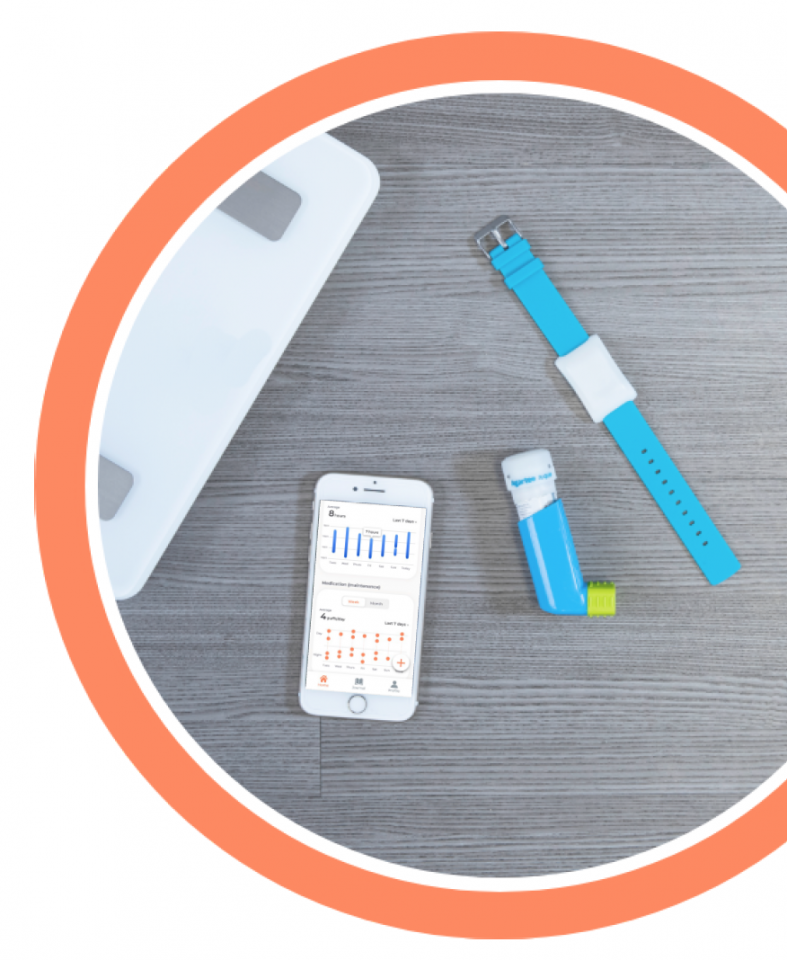People living with chronic obstructive pulmonary disease (COPD) find it difficult to learn chronic disease management skills such as knowing how and when to use their inhaled medication, how to get enough exercise, how to look after their sleep and other health habits, and when to ask for help. Health care professionals rely on their patient’s self-report of current health status in order to best support their patient’s self-management skills. However, self-report may not be accurate.
Biometric monitoring, where patients use wearable devices to measure and track their health status, may provide a more complete picture than self-report, and may also detect early changes in health status before the patient is aware, enabling quick intervention and better management of transitions in care.
Dr Pat Camp, Associate Professor in the UBC’s Department of Physical Therapy and director of the Pulmonary Rehabilitation Research Laboratory, has been working in partnership with a technology company called Vancouver based company, Agartee Technology to explore the acceptability, feasibility and potential benefit related to the implementation of remote COPD biometric monitoring (COPD Alert! Telehealth Study) into existing COPD pulmonary rehabilitation programs.
Debora Petry Moecke is a Physical Therapist and doctoral student in the UBC PhD program in Rehabilitation Sciences. She holds a master’s degree in Physiotherapy from the Universidade do Estado de Santa Catarina. (UDESC/Brazil), working in research focused on the pulmonary effects of exercise in chronic diseases and has worked as a PT in a variety of practice settings in Brazil. She was recently awarded a Mitacs Accelerate Fellowship to develop this study, as well as explore other aspects of telehealth technology as an intern with Agartee.

Project Objective
The biometric monitoring sensors monitor three important outcomes in COPD: physical activity, sleep habits and quality, and inhaler medication use. Together these measures can detect acute exacerbations of COPD, as well as determine if changes in the patient’s pulmonary rehabilitation program are required. This study will assess the acceptability and feasibility of telehealth with biometric monitoring for patients with COPD who attend pulmonary rehabilitation programs and determine if its information alerts health care professionals to self-management situations that should be addressed.
How will this research study be undertaken?
Adults diagnosed with COPD who attend pulmonary rehabilitation programs will be recruited. Each participant will wear a wristband to measure sleep and physical activity and will use a special case for their inhaler medications to track inhaler use. Devices are also available to measure exercise performance during virtual classes. Participants will be asked to live their normal day-to-day lives, while the sensors send information on the participant’s daily medication use, physical activity, and sleep quality to their rehab/clinic health caregivers.
The caregivers will use the information to decide how the participant is doing and whether they need a change in care, such as more education, change in an exercise regimen, or if they should see a doctor if they are having a flare-up of their COPD. Health outcomes will be measure at the end of the study, and both participants and the health care professionals will be asked how they felt about using the biometric monitoring equipment.
What is unique about this project?
Research has demonstrated some benefits of telehealth to people living with COPD. However, the telehealth delivery systems being explored are mostly in the form of telephone calls or web-based virtual online sessions, with no real-time behavioural, biometric or inhaled medication monitoring. What is unique about this system is that this new method is based on a remote patient monitoring system with connected smart devices that enables the health care provider to have access to real-time patient data including oxygen saturation (SpO2) and heart rate (HR) during exercise. The remote patient monitoring system also monitors daily step count, sleep quality, rescue inhaler usage and maintenance inhaler use, among other variables, which can be used by a health care provider to better predict patterns that may require medical follow-up.
Another critical aspect is that in addition to alert providers to flare-ups of COPD and enabling them to measure exercise performance during virtual classes, the system can support other chronic disease management issues in the context of pulmonary rehabilitation programs, so it may improve the rehabilitation care of people living with COPD.
Why collaboration between industry and academia matters?
The healthcare industry is going under revolutionary changes to provide support for healthy ageing at home with the adaptation of technologies such as virtual video conferencing, remote patient monitoring and artificial intelligence. Pulmonary rehabilitation programs are a key part of health management for patients with chronic respiratory conditions such as COPD.
Although industry can contribute to the accelerated development of innovative technologies, direct involvement of clinician-scientists is necessary to ensure the industry includes the best scientific practices, facts, and findings in its vision. In addition to fine-tuning the vision and confirming the results, this mutual collaboration enhances the long-term training of future leaders in both industry and academia in the long run. In the short term, the partnership advances research and development of innovations that can improve lives immediately.
That is why Agartee has been collaborating with clinicians and scientists since its inception in 2014. To help achieve the goals mentioned, organizations such as MITACS have been crucial in providing funding and other support to bridge the worlds of industry and academia.